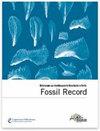Ingensalinae subfam。11 .(半翅目:飞虱亚目:飞虱总科:飞虱科),中白垩世缅甸克钦琥珀飞虱一新亚科
IF 2.1
4区 地球科学
Q1 PALEONTOLOGY
引用次数: 4
摘要
摘要根据白垩纪中期克钦(缅甸)琥珀的一个完整标本,描述了新近建立的第二属和第二种,即Ingensala xiai gen.et sp.nov.,主要根据其头部结构、前足和中足,而没有中、侧脊和足脉,可将其确定为猪科。Ingensala gen.nov.在其脉序模式上与始足目表面相似,而不是与猪笼草科模式属猪笼草属相似,并进一步证实了猪笼草亚科可能是侏罗纪稻飞虱科的后裔。在侏罗纪的齐羊伊蚊科和始新世的魏窝虫科中也发现了CuA的早期分叉和带有许多分支的茎CuA。Ingensala gen.nov.在表面上也类似于一些热带杜父科:热带杜父亚科。新属与模式属Inoderbe在很大程度上的不同之处在于:头宽,叶无顶,触角不那么细长,翅膀静止时的形态条件,被盖大、宽、透明,三角形基生细胞,单个CuA1,腿上覆盖着短刚毛,身上缺乏丝状蜡。因此,这两个属分别建立了两个新的亚科(Inoderbinae stat.nov.和Ingensalinae亚科.nov.)。植物群落的多样化可能是白垩纪中期环境变化压力的结果,猪笼草科为我们了解富尔哥罗德目的白垩纪演化和多样化提供了更多的信息。本文章由计算机程序翻译,如有差异,请以英文原文为准。
Ingensalinae subfam. nov. (Hemiptera: Fulgoromorpha: Fulgoroidea: Inoderbidae), a new planthopper subfamily from mid-Cretaceous Kachin amber from Myanmar
Abstract. The second genus and species of recently established
planthopper family Inoderbidae, Ingensala xiai gen. et sp. nov., is described based on a
well-preserved specimen from mid-Cretaceous Kachin (Burmese) amber, and it
can be definitely attributed to Inoderbidae mainly based on its head
structure, pronotum, and mesonotum without median and lateral carinae and
tegmen venation. Ingensala gen. nov. is superficially similar to Eofulgoridium regarding its
venation pattern, rather than to the Inoderbidae type genus Inoderbe, and further
confirmed that Inoderbidae might descend from the Jurassic planthopper family
Fulgoridiidae. The early fork of CuA and the stem CuA bearing many branches
also can be found in Jurassic Qiyangiricaniidae and Eocene Weiwoboidae.
Ingensala gen. nov. also superficially resembles some Tropiduchidae: Tropiduchinae.
The new genus differs from the type genus Inoderbe to a large extent according to
its wide head, frons without fastigium, antennae not so elongate, the
tectiform condition of wings' position in repose, large, broad and
translucent tegmen, triangular basal cell, single CuA1, legs covered
with short setae, and the lack of filamentous wax on body. Therefore, two
new subfamilies (Inoderbinae stat. nov. and Ingensalinae subfam. nov.) are
established for these two genera respectively. The diversification in
planthoppers could be the result of pressure of environmental changes during
the mid-Cretaceous, and Inoderbidae provides more information for us to
understand the Cretaceous stage of Fulgoroidea evolution and
diversification.
求助全文
通过发布文献求助,成功后即可免费获取论文全文。
去求助
来源期刊

Fossil Record
PALEONTOLOGY-
CiteScore
3.60
自引率
7.10%
发文量
18
审稿时长
14 weeks
期刊介绍:
Fossil Record (FR) is the palaeontological journal of the Museum für Naturkunde Berlin. This journal was founded in 1998 under the name Mitteilungen aus dem Museum für Naturkunde Berlin, Geowissenschaftliche Reihe and appears with two issues each year. Fossil Record publishes original papers in all areas of palaeontology including the taxonomy and systematics of fossil organisms, biostratigraphy, palaeoecology, and evolution. All taxonomic groups are treated, including invertebrates, microfossils, plants, and vertebrates.
 求助内容:
求助内容: 应助结果提醒方式:
应助结果提醒方式:


